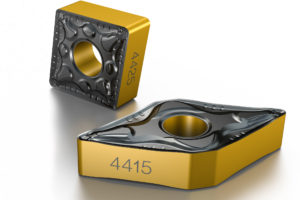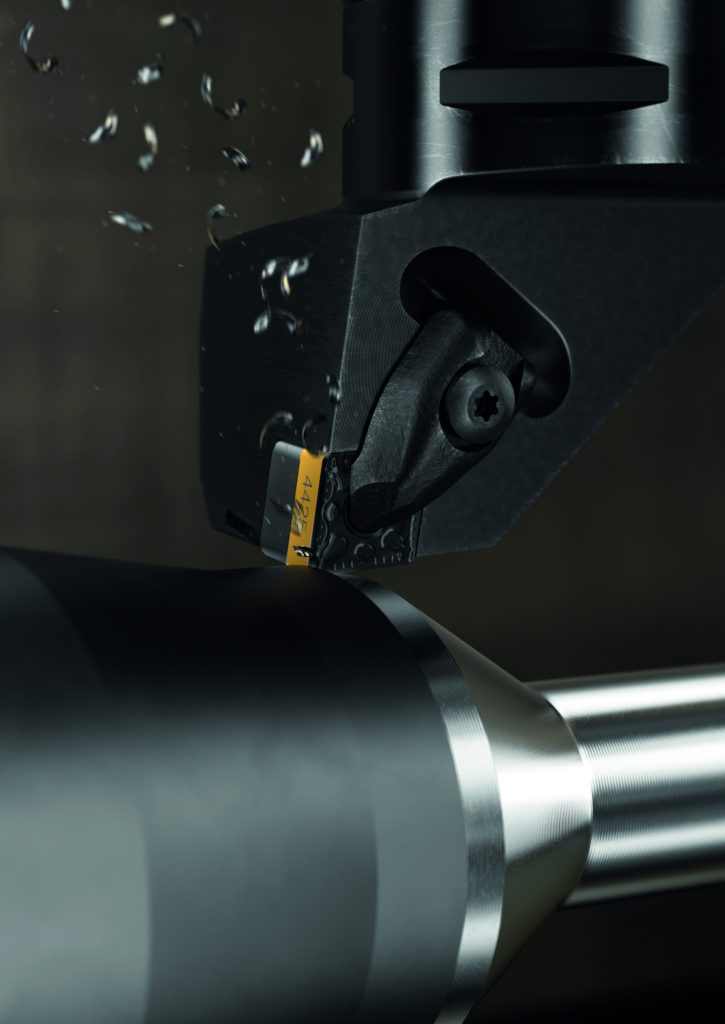This article by Mark Albert originally appeared in Modern Machine Shop magazine.
What can we learn about coping with a pandemic-distressed world from a couple of newly introduced carbide insert grades? It turns out, we can learn some useful insights and changes in thinking. One example relates to how best to evaluate flexibility for manufacturers in today’s complex, unpredictable market. Another example has to do with the way lessons learned out of this time will become part of the more normal “normal” that eventually will come. Finally, we can learn that some things never change. Even as markets are disrupted, the science of metalcutting remains the same.
Many manufacturers have been caught in one of these stressful scenarios: Either business has surged unexpectedly, or it has slumped unexpectedly. In either case, the sudden shift has called for flexibility on many levels. Having tooling designed for flexibility in difficult turning jobs is potentially more useful that manufacturers might have previously imagined, and it can be part of a paradigm of flexibility to which shops and plants might now turn.
Flexibility in Focus

The CG4415 and GC4425 inserts cover turning operations in a broad range of materials in the ISO P category. Flexibility in a tooling solution has implications for manufacturers coping with unexpectedly turbulent times. Photo credit: Sandvik Coromant.
Sandvik Coromant’s newly introduced insert grades, GC4415 and GC4425, are designed to address challenges in turning operations of ISO P category metals, which include unalloyed steel and low alloy steel. As Rolf Olofsson, a product manager at Sandvik Coromant, explains, the ISO P material groups are all notoriously tough to machine. In addition, they exhibit multiple, diverse sets of properties, making specific materials difficult to manage. Understanding the differences in each material is essential to achieving the optimal result. Olofsson contrasts turning of ISO P materials with a heat-resistant superalloy (HRSA) in the S group. “Here we probably would encounter low thermal conductivity, which causes high heat concentration in the cutting zone that can deform a cutting tool,” he says. “This single property is relatively easy to counter, but the multiple properties of an ISO P group material can be more challenging.”
For example, materials in this group may combine the adhesion properties of a low alloy steel with unusual thermal conductivity like an HRSA. In the past, countering both properties without excessive wear in an insert grade has not been practical, Olofsson says. As a result, manufacturers have had to select a grade that is more or less a compromise. They also may have to maintain an inventory of several grades to cover other materials in this group when encountered in batch manufacturing.
Olofsson reports that Sandvik Coromant has responded by devoting substantial research and development to delivering greater flexibility in steel turning. This effort, he says, revolved around increasing crystal orientation in the alumina coating layer, which delivers greater wear resistance. He adds that heat resistance and toughness also are higher. This combination expands the application range and enables a machine shop or manufacturer to help alleviate the problems of ISO P turning.
To put this into perspective, Olofsson notes that when evaluating an insert solution for a metalcutting problem, every manufacturer has to consider if it achieves at least three of the following goals: (1) increased metal removal rates, (2) more workpieces per edge, (3) reduced cycle times, (4) minimized waste and (5) optimized inventory use. An insert grade capable of machining multiple types of steel components also should be considered.
Olofsson says the GC4415 and GC4425 grades meet this test, as trial users are reporting benefits in three, four and sometimes five of these goals for specific applications. More importantly, these grades are proving successful in both mass and batch production.
So, what does flexibility mean for manufacturers? On the tooling solution level, he says the answer includes several factors, including quicker changes between batches for job shops, a minimized number of production steps to replace worn inserts for production shops, and an optimized or reduced tooling inventory for all shops. “The new level of flexibility exemplified in this particular example has implications for how, in general, manufacturers and machining companies will have to cope with the unpredictability created by the pandemic and its lasting effects,” he says.
Two Scenarios
Related to the two scenarios metalworking companies faced: Some met unexpected high demand, as a number of essential industries such as pharmaceuticals, medical equipment and food production gained pace during the lockdown. Manufacturers serving these industries needed tooling solutions with the potential to increase metal removal rates, reduce cycle times and support quick changes between production batches.
Others faced low demand or virtually total shutdown. The low-demand companies required tools that could produce more pieces per edge while providing process security, with fewer production interruptions and the possibility to run unattended.
In both the high-demand and low-demand scenarios, the same carbide inserts are advantageous because of the way the pandemic “turned the tables.” Manufacturers usually in the batch-production mode had to operate more like mass-production manufacturers and vice versa. Afterward, the inserts remain advantageous for manufacturing in their normal production mode.
Exact Science

For optimum performance, the new grade of turning inserts rely on “the exact science of metalcutting.” This is Rolf Olofsson’s phrase for making sure all elements of the setup (insert grade, toolholder, insert clamp, workpiece fixturing and so on) comply with recommended best practices and are matched with appropriate machining parameters (cutting speed, depth of cut, feed rate and so on). Photo credit: Sandvik Coromant.
Olofsson has a caveat about this understanding of flexibility. The benefits of a tooling solution, no matter how flexible it is, can be squandered if users do not rigidly adhere to what he calls “the exact science of metalcutting.” Whatever scenario job shops or mass producers find themselves in, the key to profitable production in steel turning lies in a combination of having the best setup from the machine to the cutting edge along with the knowledge of how to apply the tooling correctly, he says.
“At present, most recognize the importance of the precisely selected grade for their inserts. However, many do not realize that considering the whole tooling concept — everything from the insert grade, to the toolholder to the clamping concept — can increase output, reduce costs and deliver higher levels of process security,” he says.
More Black Swans?
Olofsson offers one more comment derived from his evaluation of the steel turning insert grades. He says, “It is fair to say that, with COVID-19, industry has experienced a black swan event,” citing a phrase given to an unpredictable and significant incident that throws other events off course.
This black swan event has forced manufacturers to make course corrections, many of which have been sudden and drastic, he says, adding that reevaluating flexibility in steel turning of tough alloys is simply one example of a production strategy recommend as part of an effective course correction. Many other changes to achieve greater flexibility in all aspects of manufacturing are in order, he says.
“Manufacturers also must sustain these objectives over the long term,” Olofsson warns.
He cites one analyst who describes the ongoing climate for manufacturers as the “next normal” in which manufacturers can expect unpredictable and lasting shifts in customer markets. Resilience will be needed if manufacturers are to navigate an economically and socially viable path.
He recognizes that his own employer, Sandvik Coromant, is in the same boat as it charts its direction in choppy waters. “We do not yet know exactly what the new post-global-pandemic normal will be. But we do understand the objectives of our customers as well as the exact science of metalcutting. By combining these insights, we believe it is possible to deliver the tools needed to support profitable machining, including challenging applications in steel turning as an especially telling example, using the exact science of metalcutting to its full potential, even during a black swan event.”